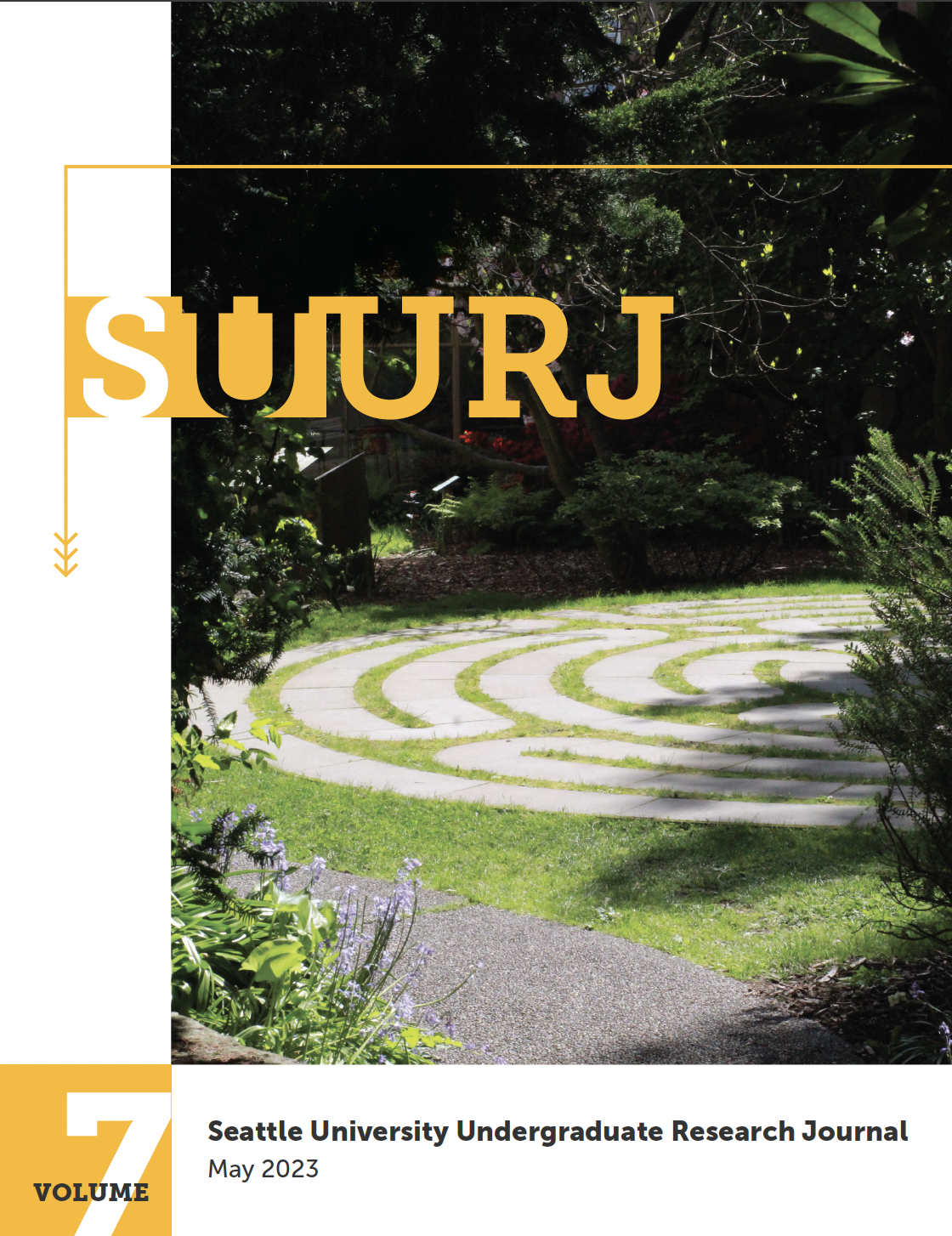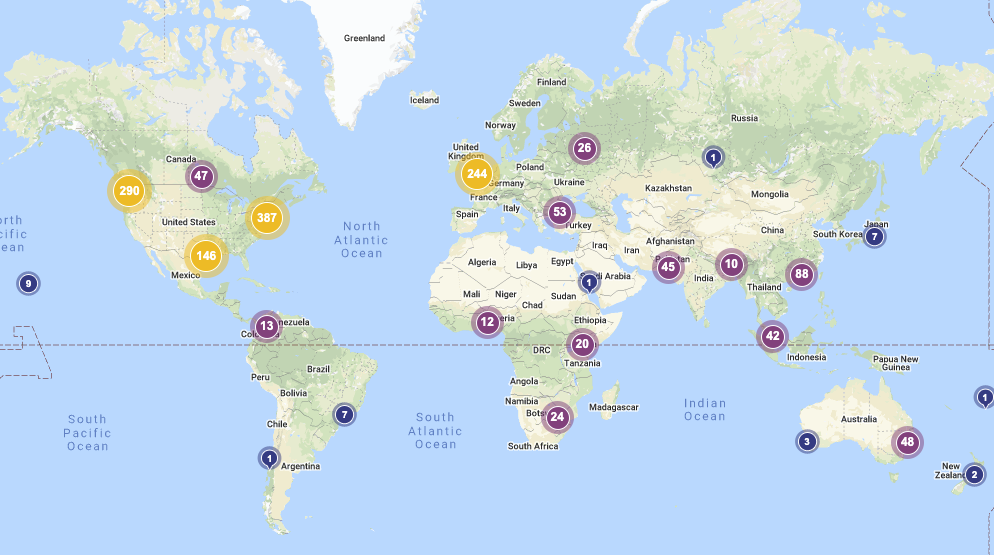
Seattle University Undergraduate Research Journal (SUURJ)
Seattle University Undergraduate Research Journal (SUURJ)
SUURJ was developed to highlight the research achievements of Seattle University undergraduate students through a peer-reviewed online publication.
SUURJ Volume 7 student editors, from L to R: Tripp Ceyssens, Olivia Moretta, Katrina Manacio, Riley Flanagan, Masami Carpenter, Olivia Merrick, and Nicole Beauvais. Not pictured: Emelia Vonada
It is also designed to provide an editorial apprenticeship experience for students through a credit-bearing program that trains students to share stewardship of the journal. Research includes any original quantitative or qualitative work that a student has conducted during their academic studies. This includes theoretical works, policy analyses, research-based editorial pieces, Core writing, and other modes.
SUURJ is a joint project of the College of Arts and Sciences, the English Department, and the Office of the Provost, with additional support from Lemieux Library and the University Core.
See the resources below to learn more about how to submit research to SUURJ or how to become a student editor.
SUURJ Resources
-
Submission Guidelines
-
Who can submit?
Any student of Seattle University in good academic standing may submit to any subject section of the journal. Students in any year of their program may submit; in addition, we will accept submissions from students who have graduated one year prior to the deadline, provided that they submit work produced while they were enrolled at Seattle University, and conforming to requirements, below.
What may be submitted?
Students may submit to any section of the journal (see About the Journal for descriptions of each subject). Manuscripts submitted for consideration must have been written no more than three quarters prior to the deadline (Winter, Spring, or Summer quarters of the same calendar year or Fall quarter of the previous calendar year). Only work produced while the student is enrolled at Seattle University may be submitted. Only one submission per student will be accepted.
-
Manuscript Preparation Guidelines
-
Before you submit your paper, you must have your faculty mentor fill out the SUURJ Faculty Mentor Form. We will not accept submissions without a completed form, so please ask your Faculty Mentor to complete and submit the form no later than October 20.
- Blind Review
You must prepare your essay so that it does not contain your name anywhere on the PDF document itself. Other portions of your application will contain your name and contact information, but the essay itself should be anonymous.
- Formatting requirements
You will fill out the online application on the submission portal, upload a copy of your manuscript in .doc or .docx format, and upload your signed faculty mentor form in PDF format.
Please double-space your manuscript and use a 12-point font, with 1-inch margins for everything including notes and captions.
Students should consult with their faculty mentors on a style appropriate to the discipline or field of research (please choose from APA, CSE, or MLA). Generally, you will use the system employed by the field for which you are writing. Consult the style guide and apply it consistently and correctly throughout the paper and the bibliography. If the essay uses another style (e.g., Chicago), this must be changed before submission. Refer to the Purdue University Online Writing Lab for assistance with style guide.
- Abstracts
The submission portal will instruct you to provide a 250-word abstract according to your discipline’s protocols.
- Figures, Images and Embedded Files
Images should be at least 150dpi, preferably in PNG, TIFF, or JPEG format. Photos, pictures, graphs, figures and tables should conform to your disciplinary specifics, and can either be embedded in the manuscript, follow at the end of the manuscript, or be attached as files with your documents. The author may use audio and/or video files that support the text. These should conform to your disciplinary specifics, and can either be embedded in the manuscript, follow at the end of the manuscript, or be attached as files with your documents.
Authors must hold or obtain copyright permission for all images and other media. All photos, pictures, graphs, figures and embedded files must be titled or captioned.
- Human Subjects Documentation
For any submission involving interviews, focus groups, surveys, or other interactions with human subjects, a student must provide all supporting correspondence—including approval—between the Institutional Review Board (IRB), student researcher, and faculty advisor. You may need to contact your faculty member to provide this correspondence and approval.
-
Submission Checklist and Instructions
-
Checklist
Before you submit, ensure that your manuscript complies with all of the following items. We cannot accept applications that do not adhere to the guidelines.
- You are submitting electronically by October 20, 2023 at 11:59 p.m.
- The submission has not been previously published, nor is it under consideration with another journal.
- You have anonymized your essay.
- The submission and application files are in a .doc or .docx file format.
- The text is double-spaced; uses 12-point font; has 1-inch margins; employs italics rather than underlining (except with URL addresses); and all illustrations, figures, and tables are included and labeled per your discipline’s style guide.
- The text adheres to the stylistic and bibliographic requirements per your discipline’s style guide, and has been converted, if necessary, to MLA, APA, or CSE style.
- The submission includes:
- Your 250-word abstract
- Your manuscript
- Your application, including:
- faculty mentor form
- IRB approval, if necessary
How to Submit an Article
From the menu on the right or from the SUURJ ScholarWorks website:
- Click on “Submit Article.”
- You will be directed to the SUURJ Scholarworks site. Click on "Submit Article" from the blue menu on the right. You will then see a Login screen. Click the "Sign-Up" button to create a ScholarWorks account. Your SU credentials will not work to log into this site.
- Once you have an account, you will be directed to enter author information.
- On the next page, you will be directed to confirm whether you are sole author, or whether there are additional authors.
- On the next page, you will be directed to enter information about your manuscript, including your abstract.
- On that same page, you will be directed to upload your manuscript.
- On that same page, you will be directed to upload your completed application.
-
For student contributors
-
Contributors’ essays undergo a content and style editorial process during winter of each year. During this term, contributors meet in person with two members of our team. The first meeting is with a faculty content editor to strengthen the content areas of the manuscript. The second meeting is with a student editor to strengthen the style of the project.
-
For student editors
-
Editors take one 5-credit pedagogy class in fall to train them in the skills needed to form and edit an interdisciplinary journal. They take part in the selection of essays and projects for that year’s issue. At the end of fall, they can apply to take a 2-credit practicum in winter and a 3-credit practicum in spring to edit and produce the journal. In winter, they edit the selected manuscripts, together with faculty content reviewers. In spring, they design, publish, and market the online issue of the journal.
SUURJ Readership
As an open-access journal, the research published in SUURJ reaches a global audience. Click through the map to see where the research completed by undergraduate students at Seattle University is being downloaded and read.
So often will students pour hours of work, time, and effort into their research, whether that be in the lab or the library, only to show it to one or two other people. SUURJ is a platform that celebrates such effort, and publishes it for all to see.
Wiley Martin Student Editor, 2017Submission Deadline for Vol. 8:
October 20, 2023

-1130x751.JPG)
